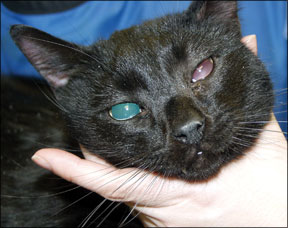Cats eyes, like those of humans and many other animals, are complex arrangements of delicate structural components that operate harmoniously in a normal, healthy animal to enable keen vision. Unfortunately, things sometimes go wrong with one or more of these components as a result of disease, aging, traumatic injury or genetically acquired defects.
Cataracts can seriously impair a cats vision and even cause blindness. Compared to the frequency of its occurrence in humans and dogs, this ocular disorder is rarely seen in cats, says Thomas Kern, DVM, associate professor of ophthalmology at Cornell

Bev Caldwell
288
Universitys College of Veterinary Medicine. Nevertheless, all cat owners should know the physical and behavioral signs of this disorder and the special needs of a visually impaired feline.
Complex Architecture
The exterior surface of the eyeball is covered by a tough, fibrous tissue (sclera) with a circular transparent window (cornea) in its center. At the center of the eye, behind the cornea, is the iris, a round, darkly pigmented membrane that contracts or expands to regulate the flow of light that enters the eye through the pupil. The entering light then passes through a crucially important component of the eye – the lens.
The lens is a small, translucent structure that adjusts its shape as needed to focus incoming light rays on the retina – a light-sensitive tissue that lines the interior surface of the back of the eyeball. When the retina receives the light impulses that have passed through the lens, it instantaneously transmits them to the brain as visual information via the optic nerve, which is attached to the back of the eyeball.
When a cataract develops, it clouds the lens and impedes, or even totally prevents, incoming light from passing through to the retina. In some cases, the opaque area is tiny and without consequence. In others, the entire lens may be opaque, in which case total blindness will result in an affected eye.
Addressing the Problem
Some feline cataracts develop as a result of an animals inability to metabolize proteins and other body chemicals, or they may be a byproduct of diabetes or hypertension. Older cats often get them as a natural consequence of the aging process. In rare instances, cataracts can develop following exposure to certain drugs or toxic substances, radiation or electric shock. And in many cases, the cause is unknown.
All cataracts, no matter the cause, function alike in that they result in vision-impairing opacity of the lens, which can affect either one or both eyes. The clearest signs of failing or complete vision loss may be behavioral. A visually impaired cat may, for example, become less mobile, bump into familiar objects or appear to have trouble finding its food bowl and litter box. “But the behavioral signs may be too subtle to notice,” Dr. Kern points out. “So the owner should routinely check the cats eyes. Look for changes in the color of the iris, for example, or see if the eye seems to be cloudy. If you see anything unusual, have the animal examined by a veterinarian.”
Treatment Options
Early treatment with a variety of medications, he says, may prevent or delay the onset of blindness. In some cases, for example, treatment for high blood pressure or diabetes will be effective in slowing the rate at which the disorder progresses.
In other cases, surgery may be required. In such a procedure, the ophthalmologist uses an operating microscope to make small incisions, first in the cornea and then in the lens capsule, before inserting an instrument that uses high-frequency sound to disintegrate and remove the affected lens. Following this, an artificial lens is inserted and the incision is sutured shut.
The delicate surgery typically takes about an hour, says Dr. Kern, who notes that the procedure is successful in most kittens or mature cats that have qualified as good candidates for implantation of the intraocular lens.



